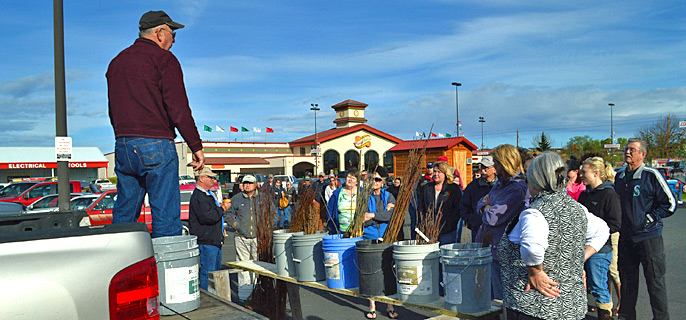By Frankie Franell
Spring is here and on Saturday the Hermiston Rotary Club and the Hermiston Parks and Recreation Department will be giving away trees beginning at 9 a.m..
If you’re thinking about planting a tree in your yard, Northeast Oregon Now is here to help. Below is a short description of each of the variety of trees that will be given away Saturday at the Smitty’s Ace Hardware parking lot:
- The red maple shows off its familiar color not only with its brilliant autumn foliage, but also with buds in winter, flowers in spring, and leafstalks in summer. Its show of color, relatively fast growth, and tolerance of a wide variety of soils make it a widely planted favorite. Click here for an image of the red maple.
- The common serviceberry produces dark green foliage and inconspicuous white flowers in spring. It has a moderate life span and slow growth rate, and it can reach 35 feet in height. It has low tolerance to drought and restricted water conditions. Click here for an image of the common serviceberry.
- The river birch grows naturally along river banks but can be planted almost anywhere as a landscape tree. It grows relatively rapidly and is valued for its unique curling bark and spreading limbs. It is tolerant of wetness and some drought and has relative resistance to birch borers. Click here for an image of the river birch.
- The green ash, heavily used as a replacement for the American elm in urban landscapes since the onset of Dutch elm disease, is popular for its hardiness, fast growth, good shade, and ability to adapt to many soil conditions. Click here for an image of the green ash.
- The tulip tree is named for its flowers and leaves. It may take 15 years for flowers to appear. The tree grows quickly, to a height of 80 to 100 feet, with a spread of about 40 feet at maturity. It grows well in several soil types, preferring normal moisture. Click here for an image of the tulip tree.
- The quaking aspen provides a soft sound when breezes cause “quaking” of its leaves, which provide stunning yellow fall color. It’s not appropriate for all places, as it reproduces primarily with sprouts from its shallow roots, forming clones. It grows well in several soil types, preferring abundant moisture. Click here for an image of the quaking aspen.
- The European mountain ash is an ornamental tree, producing clusters of white flowers after dark green leaves in spring and brilliant colors in fall. It grows to a height of 20 to 40 feet, with a spread of about 15 to 25 feet. It prefers acid, well-drained, loamy soil. Click here for an image of the European mountain ash.
- The bald cypress is a deciduous conifer with short needles that change color from spring to autumn. It grows in various soils in a pyramidal shape to a height of 50 to 70 feet, with a 25-foot spread. It adapts to wet or dry conditions and can withstand flooding. Click here for an image of the bald cypress.
- The Japanese zelkova reaches a height of up to 50 feet. It puts on a show of color in fall, and peeling bark on older trees exposes interesting orange patches. It grows in a wide range of soils, moist to dry, and tolerates wind and drought. Click here for an image of the Japanese zelkova.









